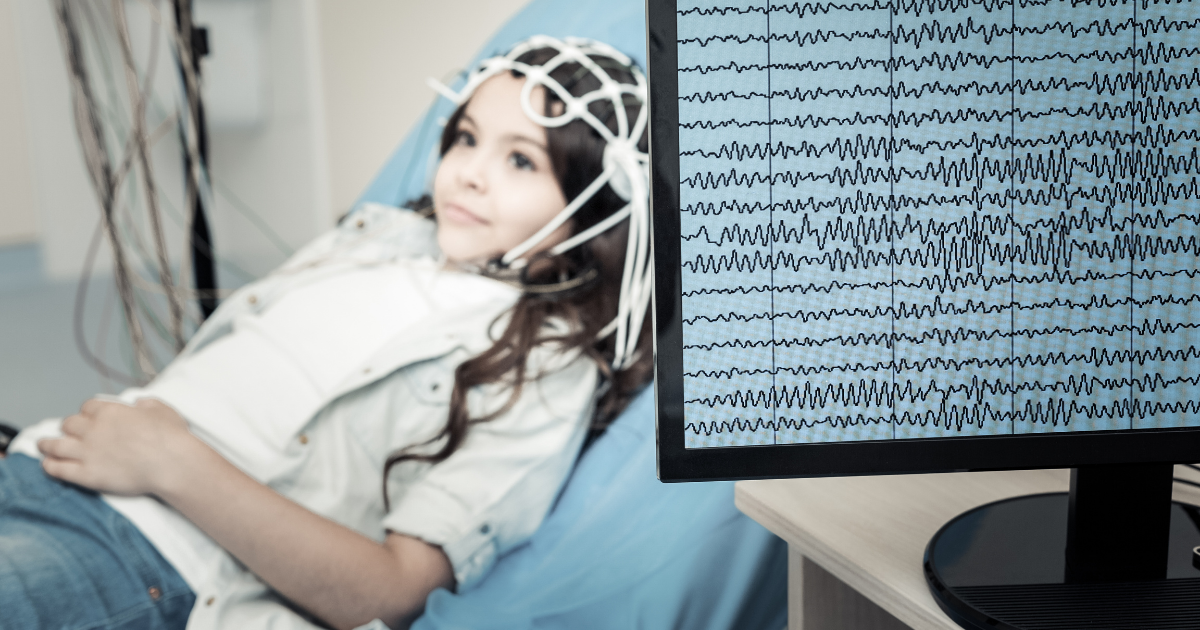
Authors: Shaun Ajinkya, MD; Elaine Wirrell, MD, Mayo Clinic – Rochester, Minnesota
Reviewed: April 2021
SUMMARY
Lennox-Gastaut syndrome (LGS) is a severe form of epilepsy. Epilepsy is a seizure disorder. LGS usually begins in the preschool years. However, it can start later in childhood.
LGS is a developmental and epileptic encephalopathy, or DEE. This means two things:
- Persons with LGS have developmental and behavioral problems as well as epilepsy
- These problems are often worsened by seizures and seizure activity
Persons with LGS have several seizure types.
A diagnosis of LGS can be supported by an electroencephalogram, or EEG.
LGS can be due to a wide range of causes.
JUMP TO
Disorder Overview
DESCRIPTION
LGS may develop in children without a history of epilepsy. It may also evolve from another type of epilepsy.
Anything that affects the brain at a critical time in its development can result in learning problems and seizures. In some cases, the exact cause of LGS is unknown.
The core features of LGS include:
- Multiple seizure types
- Seizures continue despite medication
- Particular EEG pattern
- Intellectual disability
Severity differs to some degree between patients. However, LGS is considered very severe.
LGS is a lifelong form of epilepsy. Therapies may help. However, they do not completely stop seizures. Persons with LGS have varying degrees of intellectual disability and behavioral issues. Some struggle with aggression. Some meet autism spectrum disorder criteria.
Many with LGS survive into late adulthood. However, there is an increased risk of early death known as Sudden Unexpected Death in Epilepsy (SUDEP). This is due to seizure complications. In addition, those with severe neurological disability may have limited mobility and have difficulty swallowing. This increases risk of infection, such as aspiration pneumonia. The limited mobility can also result in falls and injuries with seizures.
SIGNS AND SYMPTOMS
Age of Onset
LGS usually develops in the preschool years.
In about one in four cases, it evolves from another type of epilepsy. In these cases, it usually evolves from an epilepsy that starts very early in life. LGS most commonly evolves from infantile spasms or West syndrome.
It usually takes time for all features of LGS to appear. Therefore, it can be challenging to accurately diagnose the disease early in childhood.

Seizure Types Seen in LGS
Persons with LGS have several types of seizures. These can include:
-
- Tonic seizure. This is the most common type in LGS. They consist of neck, and sometimes arm and leg, stiffening. They often involve eye opening and upward eye rolling. They often occur in sleep. They can be subtle and easily missed. An overnight-video laboratory test can reliably detect them. If they occur in the day, while a child is upright, they can result in a fall.
- Atypical absence seizure. This type consists of brief blank-outs where a child is less aware.
- Atonic seizure. In atonic seizure, a child abruptly loses body tone and slumps. If these occur while sitting, they can look like a quick head nod. If they occur while upright, they can lead to abrupt falls and injury.
- Myoclonic seizure. These consist of isolated, brief body jerks.
- Focal impaired awareness seizure. These typically begin with staring and altered awareness. This lasts up to several minutes and are followed by a period of confusion. These seizures can progress into generalized tonic-clonic seizures.
- Generalized tonic-clonic seizure. These consist of generalized stiffening and rhythmic shaking.
Other Symptoms of LGS
Intellectual Disability
Persons with LGS nearly always have intellectual disability. It may be mild in earlier childhood. However, those with LGS often gain developmental skills more slowly. They may have moderate to severe intellectual disability by adolescence. Behavioral differences are also common. They become more of a problem with age. Behavioral issues include:
- Aggression
- Autism spectrum disorder
- Inattention
- Hyperactivity
Motor and Mobility Difficulties
Most children with LGS also have motor difficulties. These include:
- Problems with balance and coordination. This is a common motor difficulty.
- Problems with feeding and swallowing. A small number require a feeding tube.
Limited mobility and frequent seizures can also mean a higher risk of infections such as pneumonia.
Risk of Death
Children with LGS are at higher risk of death. This is for several reasons:
- Sudden Unexpected Death in Epilepsy (SUDEP). This is a major concern in LGS. The exact cause of SUDEP is not well understood. However, it may be related to post-seizure heart and breathing issues. Those with frequent convulsive seizures are at the highest risk.
- Infection. Lower mobility can lead to infection. Pneumonia is an example.
- Accidental injury. Seizures, particularly atonic or tonic seizures, may cause falling and injury.
CAUSES
In LGS, the brain is affected at a critical time in its development. Learning problems and seizures result. There are many causes of LGS. LGS is not anyone’s fault. It is highly unlikely anyone can prevent the condition.
In most but not all cases, a cause can be found. Finding it can take extensive testing. In some cases, more than one cause is found.
Structural Brain Differences
An altered brain structure is the most common cause of LGS. MRI, or magnetic resonance imaging, can detect altered brain structure. Brain structure can be affected by:
Abnormal development. This occurs when the baby is still in the womb. Often, the cause of it is unknown. However, it can result from:
- Infection during pregnancy
- Genetic abnormality
Brain injury early in life. Various types of brain injury early in life can result in LGS:
- Low oxygen or blood flow to the brain
- Brain infection
- Traumatic brain injury
- Early brain radiation
Genetic Differences
Genetic differences are important causes of early-childhood epilepsy. Some types of genetic changes result in abnormal brain development that can be seen on MRI.
In other cases, genetic causes result in changes that occur at a microscopic level. This can change how the brain functions. In these cases, the brain MRI is usually normal.
Several lab tests can look for genetic causes. However, genetic testing can have implications for relatives. Therefore, families should receive counseling prior to genetic testing.
Metabolic Disorders
Metabolic causes of LGS are rare. Still, they are important to consider. There are many types of metabolic disorders. They usually relate to difficulty breaking down nutrients in the body. They cause symptoms due to:
- A lack of an essential nutrients to keep brain cells healthy
- A toxic buildup that results in brain cell dysfunction
Some of these conditions have specific treatments. Early recognition can prevent further brain injury. Metabolic disorders can be diagnosed with lab tests. These usually include blood, urine, and spinal fluid tests. Some can be detected in genetic tests.
Infection
Infections are a rare cause of LGS.
- Prenatal infection. Viruses can infect the fetus during pregnancy. Blood tests and eye exams can usually detect prenatal infection.
- Brain infection early in life. Brain infections can lead to brain injury and a severe seizure disorder like LGS.
Immune Response
Some epilepsies result from the body creating abnormal proteins or antibodies. They can cause injury to the brain. This is an exceedingly rare cause of LGS. When seizures begin suddenly following illness or vaccination, this can be considered. It is detected in blood and spinal fluid tests.
LAB INVESTIGATIONS
There are several useful ways to investigate LGS:
EEG and Diagnosing LGS
An electroencephalogram, or EEG, is a type of medical test. It measures the electrical activity of the brain. Those with LGS will have an abnormal EEG result. Several typical electrical patterns are seen in most children with LGS.
The top two are known as:
- Generalized paroxysmal fast activity
- Generalized slow-spike and wave discharge
Imaging
MRI, or magnetic resonance imaging, can find structural causes of LGS. This may guide treatment decisions. MRI can detect:
- Cortical malformations
- Tuberous sclerosis
- Tumors
- Acquired brain injury
There is no characteristic MRI pattern for LGS. The MRI may be normal.
MRI scans are not all the same. An epilepsy-protocol MRI read by an experienced epilepsy neuroradiologist increases the likelihood of detecting an abnormality if one is present.
Genetic Testing
Sometimes, an MRI does not provide a cause. In these cases, a genetic test is recommended. These include:
- Epilepsy gene panel. This is one of the most common genetic tests for epilepsy. It looks for many different genes associated with epilepsy.
- Chromosomal microarray. This evaluates extra or missing pieces of a chromosome.
- Whole exome sequencing. This can be ordered by a genetics specialist. It evaluates the entire DNA code. It looks for changes in genes associated with epilepsy. Usually, it requires a child and both parents to be tested.
Other Lab Testing
Repeat Testing
Repeating testing or imaging in older LGS patients can be useful. It can help when an underlying cause has not been determined. It can identify previously missed causes. However, it is not necessary in all cases. Sometimes, genetic testing can be reviewed rather than repeated as knowledge about genetics grows.
Testing Costs
Insurance generally covers most tests listed above.
Genetic testing coverage varies by state and insurance provider.

TREATMENT
There are several ways to treat LGS.
Antiseizure Medication
Medications can treat LGS. They can significantly reduce the seizure frequency. However, they do not lead to freedom from seizures.
Valproic acid is a first-line medication. There are many other medications shown effective. There are several antiseizure medications that are effective in the treatment of LGS, including felbamate, rufinamide, lamotrigine, topiramate, clobazam, cannabidiol, and others.
Side Effects
All seizure medications can be associated with fatigue and sedation. Other side effects are specific to certain medications and treatments. Speak to your doctor about side effects before deciding on treatment.
Speak to your doctor about medication options and their side effects.
Dietary Therapy
The ketogenic diet can be effective in LGS. It can reduce seizures by 50% in more than half of children. The diet is:
- High fat
- Adequate protein
- Low carbohydrate
There are various types of ketogenic diet. The classical diet is the strictest. It is used mostly in infants and toddlers. Milder versions include the modified-Atkins or low-glycemic-index diets. These are better options for school-aged children, teens, and adults. Dietary therapy should be prescribed and monitored by an experienced dietician.
Surgery
Corpus callosotomy surgery can help with atonic seizures in most LGS patients. This involves separating the brain tissue on the two sides of the brain. It may be used if atonic seizures persist despite medicine and diet therapies.
In rare cases, LGS is caused by a localized brain abnormality. In these cases, surgery on that tissue can lead to fewer or no seizures.
Neuromodulation

Other management issues
Children with LGS can often benefit from ongoing physical, occupational and speech therapy. In school they usually require an Individualized Education Plan (IEP). IEP’s allow the school curriculum to be targeted to their specific needs.
Given the high medical needs of persons with LGS, families often require some type of respite care. Working with a knowledgeable social worker is important to identify resources to support families.
Costs
A 2015 report showed that average yearly medical costs are about $64,000 for LGS. This number depends on insurance status. Hospitalizations and home health services are a big expense. Many medication options are generic. They are relatively inexpensive. Newer medications, such as cannabidiol, are more expensive. However, they are generally covered by insurance.
Sometimes, a therapy is denied insurance coverage at first. However, working with a healthcare provider to appeal the decision can help.

OUTLOOK
LGS always persists into adulthood. Certain types of seizures are more common in adult with LGS than others. Over time, those with LGS experience developmental slowing, plateauing or regression. This culminates in moderate to severe intellectual disability in more than 90% of patients. Behavior disorders are common in childhood and adolescence.
Untreated seizures can lead to head injury. Those with some kinds of seizures are also at higher risk of sudden death. LGS requires lifelong antiseizure treatment.
Related Disorders
These disorders can sometimes be mistaken for LGS:
- Infantile spasms syndrome. This may progress to LGS. It can be hard to tell them apart. LGS seizures look different from spasms, however.
- Myoclonic-atonic epilepsy (or Doose syndrome). In this disorder, seizures are preceded by normal development. Persons with Doose syndrome typically have a unique seizure type called a myoclonic-atonic seizure, with a brief jerk or vocalization that precedes the fall. It is often outgrown in early childhood.
- Dravet syndrome. Dravet syndrome typically presents with recurrent prolonged seizures in the first year of life. It has its own brain and seizure pattern.
- Other early-onset DEEs. Like LGS, other DEEs include multiple types of seizures.
- Frontal lobe epilepsy. This has its own brain and seizure pattern. The seizures often have asymmetrical features.
Resources
Pediatric Epilepsy Surgery Alliance
The Pediatric Epilepsy Surgery Alliance (formerly known as The Brain Recovery Project) enhances the lives of children who need neurosurgery to treat medication-resistant epilepsy. They empower families with research, support services, and impactful programs before, during, and after surgery. PESA’s programs include research-based, reliable information to help parents and caregivers understand when a child’s seizures are drug-resistant; the risks and dangers of seizures; the pros and cons of the various neurosurgeries to treat epilepsy; the medical, cognitive, and behavioral challenges a child may have throughout life; school, financial aid, and life care issues. PESA’s resources include a comprehensive website with downloadable guides, pre-recorded webinars, and virtual workshops; an informative YouTube channel with comprehensive information about epilepsy surgery and its effects; a private Facebook group (Education After Pediatric Epilepsy Surgery) with over 300 members; Power Hour (bi-monthly open forums and live virtual workshops on various topics); and free school training to help your child’s education team understand the impact of their epilepsy surgery in school. Their Peer Support Program will connect you with a parent who has been there. The Pediatric Epilepsy Surgery Alliance also hosts biennial family conferences and regional events that allow families to learn from experts, connect with other families, and form lifelong friendships. They also provide a travel scholarship of up to $1,000 to families in need to fund travel to a level 4 epilepsy center for a surgical evaluation.
In addition, PESA has resources for medical professionals to assist in helping clinicians help the parents of their patients find the resources they need after surgery. Educators and therapists will also find helpful resources and information, including videos, guides, and relevant research. Patients who have undergone surgery are encouraged to register with the Global Pediatric Epilepsy Surgery Registry to help set future research priorities.
LGS Foundation
The LGS Foundation’s mission is to improve the lives of individuals affected by Lennox-Gastaut syndrome (LGS) through research, family support programs, and education. The LGS Foundation also hosts a private LGS Facebook Group.

Child Neurology Foundation (CNF) solicits resources from the community to be included on this webpage through an application process. CNF reserves the right to remove entities at any time if information is deemed inappropriate or inconsistent with the mission, vision, and values of CNF.
Research
ClinicalTrials.gov for Lennox-Gastaut syndrome are clinical trials that are recruiting or will be recruiting. Updates are made daily, so you are encouraged to check back frequently.
ClinicalTrials.gov is a database of privately and publicly funded clinical studies conducted around the world. This is a resource provided by the U.S. National Library of Medicine (NLM), which is an institute within the National Institutes of Health (NIH). Listing a study does not mean it has been evaluated by the U.S. Federal Government. Please read the NLM disclaimer for details.
Before participating in a study, you are encouraged to talk to your health care provider and learn about the risks and potential benefits.
Family Stories
LGS: Family Stories
The LGS Foundation shares Personal Stories of inspiration and hope from parents of children who are living with Lennox-Gastaut syndrome.
The information in the CNF Child Neurology Disorder Directory is not intended to provide diagnosis, treatment, or medical advice and should not be considered a substitute for advice from a healthcare professional. Content provided is for informational purposes only. CNF is not responsible for actions taken based on the information included on this webpage. Please consult with a physician or other healthcare professional regarding any medical or health related diagnosis or treatment options.
References
Sachdeo RC, Glauser TA, Ritter F, et al. A double-blind, randomized trial of topiramate in LGS. Topiramate YL Study Group. Neurology 1999;52(9):1882–1887. http://doi.org/10.1212/WNL.52.9.1882
Siegel H, Kelley K, Stertz B, et al. The efficacy of felbamate as add-on therapy to valproic acid in the LGS. Epilepsy Res 1999;34(2–3):91–97. http://doi.org/10.1016/S0920-1211(98)00119-3
Efficacy of felbamate in childhood epileptic encephalopathy (LGS). The Felbamate Study Group in LGS. N Engl J Med 1993;328(1):29–33. http://doi.org/10.1056/NEJM199301073280105
Motte J, Trevathan E, Arvidsson JF, et al. Lamotrigine for generalized seizures associated with the LGS. Lamictal Lennox-Gastaut Study Group. N Engl J Med 1997;337(25):1807–1812. http://doi.org/10.1056/NEJM199712183372504
Vassella F, Pavlincova E, Schneider HJ, et al. Treatment of infantile spasms and LGS with clonazepam (Rivotril). Epilepsia 1973;14(2):165–175. http://doi.org/0.1111/j.1528-1157.1973.tb03953.x
Glauser T, Kluger G, Sachdeo R, et al. Rufinamide for generalized seizures associated with LGS. Neurology 2008;70(21):1950–1958. http://doi.org/10.1212/01.wnl.0000303813.95800.0d
Lee YJ, Kang HC, Lee JS, et al. Resective pediatric epilepsy surgery in LGS. Pediatrics. 2010. http://doi.org/10.1542/peds.2009-0566
Pillay N, Archer JS, Badawy RAB, Flanagan DF, Berkovic SF, Jackson G. Networks underlying paroxysmal fast activity and slow spike and wave in LGS. Neurology. 2013;81(7):665-673. http://doi.org/10.1212/WNL.0b013e3182a08f6a
Goldsmith IL, Zupanc ML, Buchhalter JR. Long-term seizure outcome in 74 patients with LGS: Effects of incorporating MRI head imaging in defining the cryptogenic subgroup. Epilepsia. 2000. http://doi.org/10.1111/j.1528-1157.2000.tb00179.x
Genton P, Guerrini R, Dravet C. The Lennox-Gsataut syndrome. In: Meinardi H, ed. Handbook of Clinical Neurology: The Epilepsies. Amsterdam: Elsevier; 2000:211-222.
Vignoli A, Oggioni G, De Maria G, et al. Lennox–Gastaut syndrome in adulthood: Long-term clinical follow-up of 38 patients and analysis of their recorded seizures. Epilepsy Behav. 2017. http://doi.org/10.1016/j.yebeh.2017.09.006
Kerr M, Kluger G, Philip S. Evolution and management of LGS through adolescence and into adulthood: are seizures always the primary issue? Epileptic Disord. 2011;13(S1):15-26. doi:10.1684/epd.2011.0409
Kim HJ, Kim HD, Lee JS, Heo K, Kim DS, Kang HC. Long-term prognosis of patients with LGS in recent decades. Epilepsy Res. 2015. http://doi.org/10.1016/j.eplepsyres.2014.11.004
Asadi-Pooya AA. LGS: a comprehensive review. Neurol Sci. 2018 Mar;39(3):403 414. http://doi.org/10.1007/s10072-017-3188-y
Reaven NL, Funk SE, Montouris GD, Saurer TB, Story TJ. Burden of illness in patients with possible LGS: A retrospective claims-based study. Epilepsy Behav. 2018 Nov;88:66-73. http://doi.org/10.1016/j.yebeh.2018.08.032
Dibué M, Greco T, Spoor JKH, Tahir Z, Specchio N, Hänggi D, Steiger HJ, Kamp MA. Vagus nerve stimulation in patients with LGS: A meta-analysis. Acta Neurol Scand. 2020 Nov 13. http://doi.org/10.1111/ane.13375
Yoo JY, Panov F. Identification and Treatment of Drug-Resistant Epilepsy. Continuum (Minneap Minn). 2019 Apr;25(2):362-380. http://doi.org/10.1212/CON.0000000000000710
Abou-Khalil BW. Update on Antiepileptic Drugs 2019. Continuum (Minneap Minn). 2019 Apr;25(2):508-536. http://doi.org/10.1212/CON.0000000000000715
